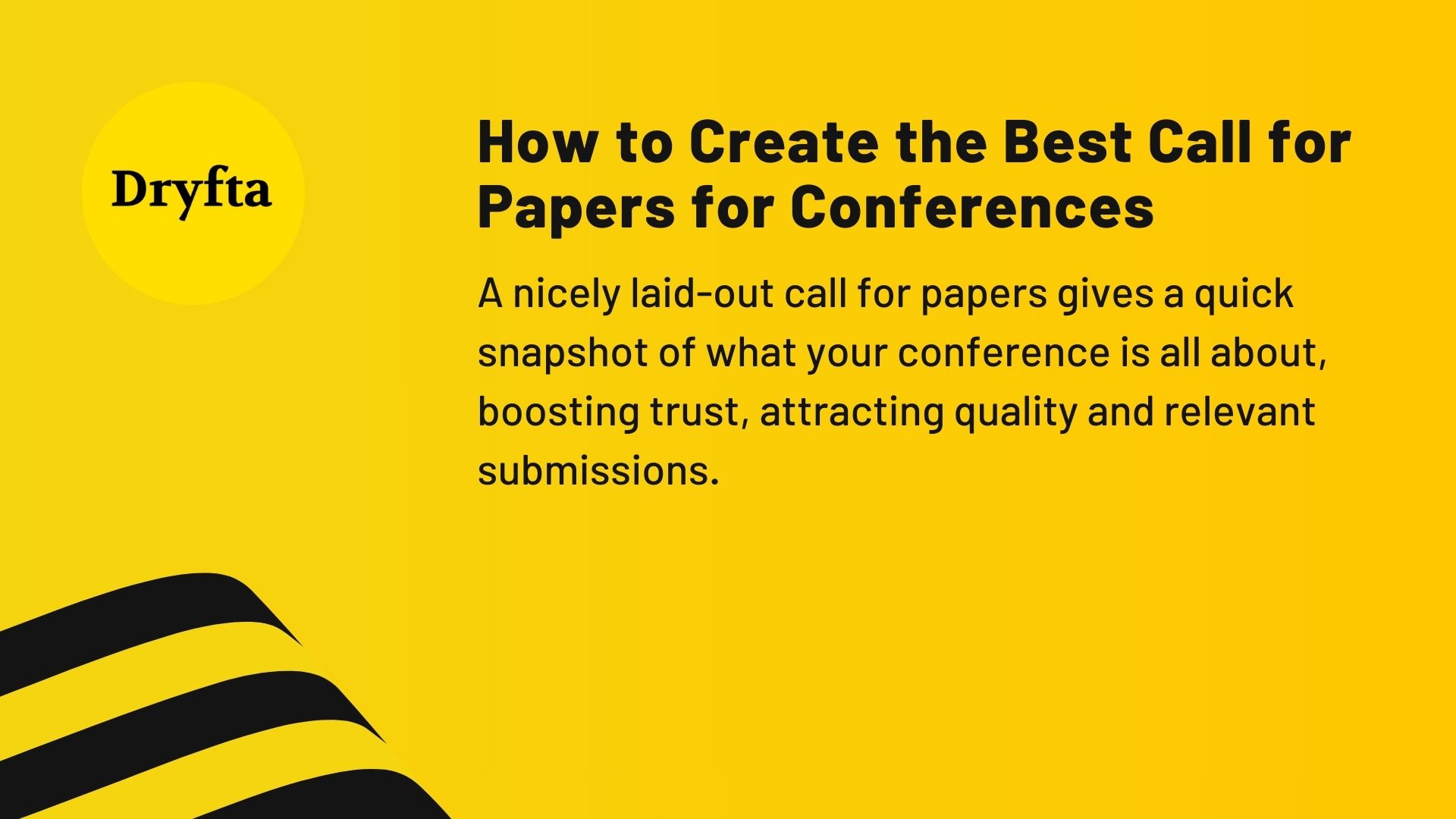
Creating a good Call for Papers (CFP) for your academic conference can have a huge impact. They act as the backbone that makes or breaks your academic event. The CFP is a powerful invitation. They are not just an announcement. They are a doorway to the academic conference. A well-written CFP is your conference’s first impression. As the old saying goes, first impressions matter the most. It sets the tone, attracts the right speakers for your academic conference, and boosts the overall engagement rates.
In this article, let’s dive deeper and understand why Call for Papers are important, essential elements of CFP, and a few important tips for crafting an appealing CFP for your academic conferences.
Why Does Call for Papers (CFP) Matter?
A well-executed CFP is an essential part of academic event planning. These conferences are the best opportunities for scholars to present their research work. The advancements in technology and digital solutions gave rise to several virtual events globally. There are more opportunities to participate in these virtual events in comparison to in-person conferences, which require spending more time and effort.
The academic conference organizers must create an interesting, clear, and charismatic call for papers to attract a good quantity of papers from qualified candidates who are willing to actively participate in the event.
Have Clear Expectations: A CFP with clear details and submission instructions makes it simple for potential candidates to know the process and follow it with their submissions. This helps reduce the confusion and maximizes the likelihood of attracting more high-quality submissions that meet the standards of an academic conference.
Attracting High-Quality Submissions: A well-written CFP attracts attendees whose research complements the themes of your academic conference. Always ensure that you are open to work that is beneficial to your audience by explicitly outlining the theme of your event.
Optimizing the Review Process: Using a comprehensive CFP template helps the reviewers to evaluate submissions in a timely manner using the latest industrial standards. The review process runs more smoothly for both organizers and researchers when a defined structure is in place, since it saves a lot of time and guarantees that all abstracts are assessed fairly.
Essential Elements for an Appealing Call for Papers
To attract the most qualified scholars and ensure a seamless submission process. It is very important to focus primarily on the structure of the Call for Papers (CFP). Let’s have a look at the main elements to include for a successful CFP:
Conference Overview
Give a clear and brief overview of the academic event:
Event Name: Provide the title of the academic conference.
Location and Date: Irrespective of the conference’s mode, whether in-person, hybrid, or virtual. Always include the location, date, and platform on which it is getting organized.
Organizers: Give the details related to the organization committee or institution that is conducting the conference.
Subjects and Themes
Mention the subjects and themes you are seeking submissions for. This makes it easier for prospective contributors to decide if their research work fits your event or not.
Example: We welcome submissions on subjects such as, but not restricted to:
-
- Mitigation of Climate Change.
- Advancements in Renewable Energy.
- Environmental Policy and Governance for Sustainable Agriculture, with a focus on the Policy Implications for Developing Nations.
Submission Guidelines
Give clear instructions with a proper set of guidelines. So, the submission process becomes easy:
-
- Abstract Submission: Include word count limits, structure, and formatting details.
- Complete Research Paper Submission: Clearly provide details related to formatting guidelines and templates, if there are any, for the full paper.
- Submission Platform: Specify whether submissions should be made online or by email, and provide relevant links or contact details. If you are using any platform like Dryfta, mention the details and steps to submit the abstracts and papers through it.
Mention Dates
A well-presented call for papers consists of all the necessary details and highlights the expected timeline for submissions.
-
- Submission Deadline for Abstracts: [Date]
- Acceptance: [Date]
- Full Paper Submission Deadline: [Date]
- Conference Dates: [Date]
Criteria for Review
Knowing the process of evaluation is helpful for both organizers and researchers. It increases fairness and eliminates bias.
Describe the review process for submissions:
-
- Application: To what extent does the submission correspond with the subjects of the academic conference?
- Originality: Does the paper offer the latest and insightful information?
- Specificity: Is the writing clear and simple to read and understand?
Contact Details
It is important to mention the contact information in the CFP. This helps clarify any queries and smooth submission.
-
- For questions, use this email address.
- For urgent matters, please include a phone number.
- Visit the website to learn more about the event.
Tips for Writing the Best Call for Papers for Conferences
Based on your academic event’s objective, you will receive abstracts from every nook and cranny of the world. Some of the most essential tips for crafting a compelling CFP are:
1. Core Objective
Before getting excited about receiving submissions from all over the world, be sure about the types of papers and relevant topics you are expecting. Every conference will have a specific theme of its own. So, it is important to clearly mention what your focus is and what kind of papers you are looking for in your current conference.
2. Highlight the Event’s Value
Keynote speakers are essential for drawing attention to your event, establishing its tone, and boosting its credibility. In your request for papers, be sure to emphasize these influential professionals and their contributions. Potential authors and delegates are usually drawn by the speaker’s fame and recognition. This helps in maximizing the engagement.
3. Usage of Language and Style
A CFP must be around 200 to 300 words only. Providing a brief and simple message that highlights the important details will attract more qualified scholars. Always avoid unnecessary jargon, ambiguity, and redundancy. Clearly state all the instructions related to word count limit, page limit, plagiarism, formats, concepts to cover, a few samples from past events, and templates for better understanding. A straightforward message always gets easily noticed.
4. Subject Line for Direct Emails
Sending direct emails is the best way to reach out to potential conference speakers and presenters. Make sure to come up with a compelling subject line for these direct emails. Generic subject lines such as “Calling for Abstracts” can go unnoticed or get into spam folders. The subject line of your email should be 100% clear and to the point that reflects the email’s main purpose.
It is also a good idea to attach a link in the email that redirects to the abstract submission site. Sending a call through these direct emails looks more professional than an indirect email, as you’re serious about getting them to submit the latest research papers.
5. Mention the Advantages
Give reasons to the scholars exactly what they will get by participating in your event. Tell them how their research work will be published and where it will be showcased.
How will it help them expand their network? How do they get a platform to speak alongside some of the leading voices in their field? Talk about the benefits you are offering them via the academic conference. Once their work gets accepted, it will be featured in post-event blogs, social media content, or recordings. Clearly highlighting these visibility matters gives your event more exposure.
6. Use Social Media Actively
If you want your event to have more younger scholars submit their papers, promote your event widely on the top social media platforms. Create a specific hashtag for your call for papers. Keep posting about your event and what it offers, and what kind of subjects and topics will be presented and spoken about.
Give a glimpse of the requirements related to the submission process as well as the deadline. You can also place the link to your submission site on your social media profile for instant access.
7. Ask for Help from a Famous Person
When a renowned and influential person is involved in something, many people get attracted and react favorably. For an affordable fee, you can get in touch with a well-known speaker in the field that is relevant to your conference’s theme. Ask them to promote your CFP on their website and social media accounts.
If you have someone who is famous and can do it for free, then approach and request them to promote your event. They can post about it on their social media platforms and share it among their contacts. Apart from this, you can invite them to speak at your conference as a keynote speaker. Your conference will look more genuine and get more potential paper contributors if a well-known person is connected to it.
8. Provide Steps and Guidelines
Make use of concise paragraphs, bullet points, and simple steps to follow. Give the scholars a clear checklist or a template that can be easily downloaded to help them with the submission process. You can expect to receive more completed submissions if you make the process seamless. Include a direct link and quick instructions if you’re using an online platform like Dryfta so they can get started right away.
9. Use a Submission Platform
To streamline and properly manage all the submissions that you’ll be receiving, you can always use an abstract management platform like Dryfta to keep all your submissions in order. Using a reliable online platform for call for papers will help to reach qualified researchers.
These online platforms also decrease the load you get in the form of emails, queries, abstracts, and paper submissions, and simplify the overall submission and review process. They also ensure fairness for all participants and eliminate any type of bias.
10. Carefully Select the Recipient List
To prevent distorting the outcomes of your CFP campaign, make sure your recipient list is targeted. Mainly concentrate on people who are actually interested in getting your emails. Start by including previous conference results, like who the top authors, speakers, and delegates were. Mention past stats and what you are expecting in the current event to make it successful.
11. Involve Reader
Instead of creating a basic letter, your call for papers should feel like a cordial invitation. Use friendly, quirky language that captures the essence of your event and inspires qualified scholars to actively participate. To establish a more engaging connection, include a quote from a previous speaker or a quick statement. You can also include testimonials from the past event’s attendees and their experience.
To Sum Up
It can take a lot of work to create a call for papers for your academic conference, but adopting the right approaches makes it easier. To ensure that your CFP is seen and heard widely, make use of every available communication channel. Aside from that, keep in mind that you will be handling thousands of applications; therefore, you must process them as quickly as possible.
Use the right tools to manage your CFP process to avoid any burden or wastage of time. To create an unforgettable event and make it successful, streamline the whole process and focus on what is important. This way, you can get many contributions from the top-tier research scholars.
Book a free demo today to see how Dryfta can help you to effortlessly manage submissions, get the best quality contributions, and elevate your event to the top level!




